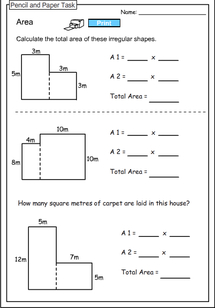
Math:
The month of February we are studying geometry. The main objective is for students to be able to classify polygons by the number of sides. Students need to focus mostly on classifying quadrilaterals by their attributes. (parallelogram, rhombus, trapezoid, rectangle, and square)
In math students are also working on measurement of polygons. They must understand how to find the perimeter and area of different polygons. The most challenging is finding the area or perimeter of irregular polygons like the example.
Since students now understand the process of multiplication, they need to start memorizing their multiplication facts. We will be sending home a sheet explaining which facts they need to practice each week. By the end of 3rd grade they should have all of their math facts memorized.
Begin practicing at home! There are so great apps that help students memorize their facts:
Meteor math
Mt. Multiplis
Tom's times tables
Math Doodle times tables
Math flashcards
Everyday math beat the computer- Multiplication
Coming soon to math: fractions
Science:
We are learning about how the sun and an object creates shadows. Later in February we will be learning about friction and convection vs conduction.
Social Studies:
In honor of black history month, we will be studying black history in Charlotte, NC. We will study how Charlotte has changed over the years and some of the brave people who made a difference.
Coming Soon to social studies and science: the study of landforms and how people adapt them
Literacy:
We have begun the study of folktales this includes: fairy tales, fables, myths, and tall tales. We will focus on fables and being able to identify the moral or theme of a story. A common mistake children make is taking the lesson too literal. A fable has a lesson that can be applied any time in life. This is hard for our students to see, they often she is as the story told it. For example, in the "Tortoise and the Hare," your child might say the lesson is that the Hare needed to go fast and not take a break. It would be true but the children need to see how to apply it to everyone. Practice reading fables at home and looking for the morals that are timeless.
The month of February we are studying geometry. The main objective is for students to be able to classify polygons by the number of sides. Students need to focus mostly on classifying quadrilaterals by their attributes. (parallelogram, rhombus, trapezoid, rectangle, and square)
In math students are also working on measurement of polygons. They must understand how to find the perimeter and area of different polygons. The most challenging is finding the area or perimeter of irregular polygons like the example.
Since students now understand the process of multiplication, they need to start memorizing their multiplication facts. We will be sending home a sheet explaining which facts they need to practice each week. By the end of 3rd grade they should have all of their math facts memorized.
Begin practicing at home! There are so great apps that help students memorize their facts:
Meteor math
Mt. Multiplis
Tom's times tables
Math Doodle times tables
Math flashcards
Everyday math beat the computer- Multiplication
Coming soon to math: fractions
Science:
We are learning about how the sun and an object creates shadows. Later in February we will be learning about friction and convection vs conduction.
Social Studies:
In honor of black history month, we will be studying black history in Charlotte, NC. We will study how Charlotte has changed over the years and some of the brave people who made a difference.
Coming Soon to social studies and science: the study of landforms and how people adapt them
Literacy:
We have begun the study of folktales this includes: fairy tales, fables, myths, and tall tales. We will focus on fables and being able to identify the moral or theme of a story. A common mistake children make is taking the lesson too literal. A fable has a lesson that can be applied any time in life. This is hard for our students to see, they often she is as the story told it. For example, in the "Tortoise and the Hare," your child might say the lesson is that the Hare needed to go fast and not take a break. It would be true but the children need to see how to apply it to everyone. Practice reading fables at home and looking for the morals that are timeless.
 RSS Feed
RSS Feed
